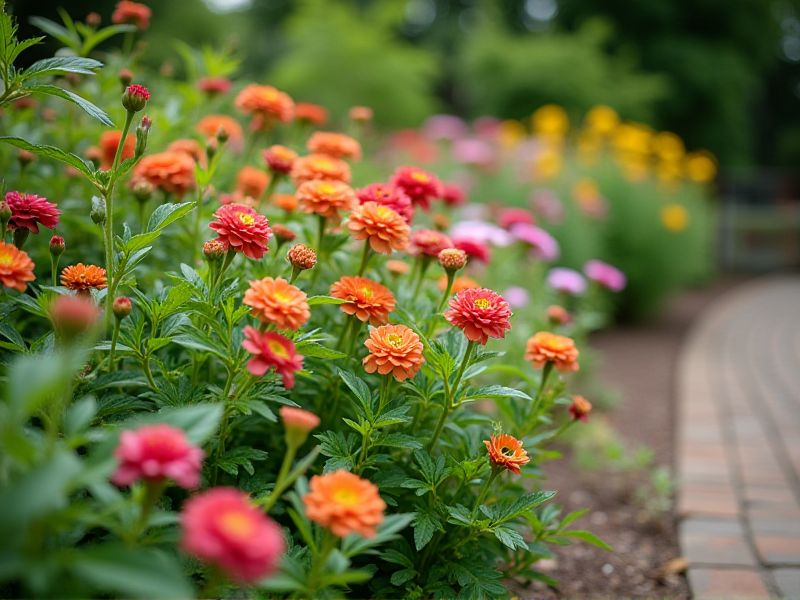
Border plants can transform your garden's aesthetic by introducing vibrant colors throughout the seasons. Consider using Salvia, whose purple or blue spikes attract pollinators, creating a lively atmosphere. Marigolds offer bright yellows and oranges, thriving in sunny spots while providing pest resistance. For a touch of elegance, Petunias come in various hues, flourishing in both borders and containers. When selecting border plants, ensure they have similar light and water requirements for a harmonious look.
List of some Border plants that add color
- Daylily (Hemerocallis)
- Lavender (Lavandula)
- Coral Bells (Heuchera)
- Japanese Iris (Iris ensata)
- Bee Balm (Monarda)
- Coneflower (Echinacea)
- Salvia (Salvia officinalis)
- Blanket Flower (Gaillardia)
- Russian Sage (Perovskia atriplicifolia)
- Penstemon (Penstemon digitalis)
Important things about Border plants that add color
Flowering Perennials
Border plants like daylilies, echinacea, and phlox are ideal flowering perennials that can enhance your garden's aesthetic appeal with vibrant colors. Daylilies bloom in a variety of hues, creating a stunning display from spring to summer, while echinacea, or coneflowers, attract pollinators and offer resilient, daisy-like flowers in purple, pink, and white. Planting phlox provides clusters of intensely colored blooms that can fill your borders and thrive in sunny areas, bringing life and vibrancy throughout the growing season. Incorporating these perennials into your landscape not only adds visual interest but also supports local ecosystems by attracting bees and butterflies.
Vibrant Annuals
Border plants featuring vibrant annuals are essential for enhancing garden aesthetics and creating visually appealing landscapes. Varieties like petunias, marigolds, and zinnias provide a burst of color throughout the growing season, thriving in well-drained soil with ample sunlight. By selecting a mix of heights and colors, you can craft a dynamic border that invites admiration and encourages pollinators. For maximum impact, consider seasonal rotations to maintain freshness and sustain a lively garden environment.
Foliage Contrast
Border plants play a crucial role in enhancing garden aesthetics by providing vibrant foliage contrast. Varieties such as Coleus, with its multicolored leaves, create stunning visual interest alongside traditional green plants. Another excellent option is Heuchera, known for its stunning shades of burgundy, purple, and silver, which add depth and texture to your borders. Incorporating these colorful border plants can transform a dull garden space into a lively tapestry of hues, enriching your outdoor experience.
Seasonal Bloom Times
Border plants such as Salvia, Echinacea, and Coreopsis offer vibrant blooms throughout various seasons, enhancing your garden's aesthetic appeal. Salvia, known for its deep blue and purple flowers, typically blooms from late spring to early summer, attracting pollinators like bees and butterflies. Echinacea, or coneflower, blooms from mid-summer to early fall, showcasing daisy-like petals in shades of pink, orange, and white. Coreopsis, often referred to as tickseed, adds splashes of yellow and gold from late spring to early fall, creating a cheerful border that draws the eye and supports local wildlife.
Height Variation
Border plants that add color can vary significantly in height, creating a visually dynamic landscape. For instance, dwarf varieties like the *Dianthus* provide a low-growing option that can create a vibrant edge, typically reaching heights of 6 to 12 inches. In contrast, taller plants such as *Salvia* or *Rudbeckia*, which can grow up to 3 feet, create a stunning backdrop with their colorful blooms. Selecting a mix of these heights not only enhances your garden's aesthetic but also allows for layering that showcases each plant's unique features.
Sunlight Requirements
Border plants that thrive in full sun include the vibrant Salvia and the cheerful Marigold, both known for their ability to withstand heat and bloom profusely. These plants not only add a splash of color but also attract pollinators like bees and butterflies, enhancing your garden's biodiversity. If you're looking for options for partial shade, consider the elegant Astilbe or the striking Hosta, which provide lush foliage and unique textures. Choosing the right border plants based on sunlight exposure ensures your garden remains healthy and visually appealing throughout the growing season.
Soil Preferences
Border plants that add vibrant color thrive in well-drained, nutrient-rich soils, making them ideal for enhancing garden aesthetics. Popular choices include vibrant dahlias, luminous marigolds, and striking salvia, which not only provide visual appeal but also attract pollinators. When selecting these plants, consider a soil pH between 6.0 and 7.0 for optimal growth, ensuring they receive adequate sunlight and moisture. You can also incorporate organic compost to improve soil fertility and drainage, promoting healthier, more colorful blooms throughout the growing season.
Maintenance Needs
Border plants such as *Salvia*, *Lavender*, and *Marigolds* enhance garden aesthetics while requiring low to moderate maintenance. Regular deadheading encourages continuous blooms, while a well-draining soil ensures healthy root systems. To maintain vibrant colors, consider fertilizing with a balanced feed during the growing season and monitor for pests like aphids or spider mites. Proper spacing allows for air circulation, which minimizes disease risk while showcasing the vivid hues of your border plants.
Attracting Pollinators
Border plants such as Echinacea, also known as coneflowers, bloom with vibrant colors that attract essential pollinators like bees and butterflies. These hardy perennials thrive in various soil types and require minimal maintenance, making them perfect for border gardens. Incorporating flowers such as Salvia and Sedum not only enhances the visual appeal of your garden but also provides a vital food source for these beneficial insects. By strategically selecting border plants that produce nectar-rich blooms, you can create a lively and productive ecosystem that supports pollinator health.
Companion Planting Options
Border plants that add vibrant color not only enhance the aesthetic appeal of your garden but also promote healthy growth through companion planting. For instance, marigolds are excellent border plants, known for their bright yellow and orange blooms while deterring pests like nematodes. Another beautiful option is the salvia, which offers striking blue and purple spikes, attracting pollinators and providing essential nectar to butterflies and bees. Incorporate these colorful companions at the edges of your garden beds to create a visually stunning and ecologically balanced space.
